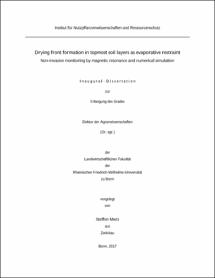Merz, Steffen: Drying front formation in topmost soil layers as evaporative restraint : Non-invasive monitoring by magnetic resonance and numerical simulation. - Bonn, 2017. - Dissertation, Rheinische Friedrich-Wilhelms-Universität Bonn.
Online-Ausgabe in bonndoc: https://nbn-resolving.org/urn:nbn:de:hbz:5n-47019
Online-Ausgabe in bonndoc: https://nbn-resolving.org/urn:nbn:de:hbz:5n-47019
@phdthesis{handle:20.500.11811/7015,
urn: https://nbn-resolving.org/urn:nbn:de:hbz:5n-47019,
author = {{Steffen Merz}},
title = {Drying front formation in topmost soil layers as evaporative restraint : Non-invasive monitoring by magnetic resonance and numerical simulation},
school = {Rheinische Friedrich-Wilhelms-Universität Bonn},
year = 2017,
month = apr,
note = {Prediction of soil moisture changes on large scales is of various interests with regard to water resources management. Within this PhD work, different Magnetic Resonance (MR) concepts/apparatus and sequences were applied and assessed to monitor changes in the moisture content of evaporating soils on various scales in high resolution non-invasively while focusing on their field applicability. Particularly focus was spent on the origin of the dry surface layer as it is predicted by theory. Since the concept of single sided MR is of great potential for direct field applications a unilateral single sided sensor and a three magnet array were employed and the result were compared to measurements performed on stationary MR magnets of different concepts. Since soil naturally possess paramagnetic impurities and the clay content can vary considerably, MR measurements become challenging in terms of a decreasing signal to noise ratio (SNR) together with significantly accelerated signal decay what gets particularly tricky with progressing desaturation. These inherent soil properties justify the need for feasible MR pulse sequences which ideally reduce signal decrease by relaxation acceleration due to internal and external magnetic field gradients and short detection times to reduce signal loss. The MR data was used to evaluate the coupled model approach since this model is favorable over the classical Richards approach when focusing on the origin and development of a dry surface layer at S2 evaporation over time. Concluding on the basis of the conducted experiments , 1H MR as a huge potential for non-invasive monitoring of water content and water environment (pores) of opaque porous systems such as soils from the mm to the cm scale in high spatial resolution. The fact that robust and fast MR methods need to be employed when investigating moisture changes in the top layer of desaturated soils in the field entails the need for MR apparatuses particularly designed for field measurements. A less heavy setup is required where fast methods can be applied which does not considerably compact the soil, does not suffer from low SNR and is immune to parasitic frequencies. Next to measurements, there is a constant need to improve the estimation of soil water fluxes what involves the improvement of soil water flow models. This inevitable step will help us to gain a better understanding of water depletion in and from topmost soil layers at progressing desaturation.},
url = {https://hdl.handle.net/20.500.11811/7015}
}
urn: https://nbn-resolving.org/urn:nbn:de:hbz:5n-47019,
author = {{Steffen Merz}},
title = {Drying front formation in topmost soil layers as evaporative restraint : Non-invasive monitoring by magnetic resonance and numerical simulation},
school = {Rheinische Friedrich-Wilhelms-Universität Bonn},
year = 2017,
month = apr,
note = {Prediction of soil moisture changes on large scales is of various interests with regard to water resources management. Within this PhD work, different Magnetic Resonance (MR) concepts/apparatus and sequences were applied and assessed to monitor changes in the moisture content of evaporating soils on various scales in high resolution non-invasively while focusing on their field applicability. Particularly focus was spent on the origin of the dry surface layer as it is predicted by theory. Since the concept of single sided MR is of great potential for direct field applications a unilateral single sided sensor and a three magnet array were employed and the result were compared to measurements performed on stationary MR magnets of different concepts. Since soil naturally possess paramagnetic impurities and the clay content can vary considerably, MR measurements become challenging in terms of a decreasing signal to noise ratio (SNR) together with significantly accelerated signal decay what gets particularly tricky with progressing desaturation. These inherent soil properties justify the need for feasible MR pulse sequences which ideally reduce signal decrease by relaxation acceleration due to internal and external magnetic field gradients and short detection times to reduce signal loss. The MR data was used to evaluate the coupled model approach since this model is favorable over the classical Richards approach when focusing on the origin and development of a dry surface layer at S2 evaporation over time. Concluding on the basis of the conducted experiments , 1H MR as a huge potential for non-invasive monitoring of water content and water environment (pores) of opaque porous systems such as soils from the mm to the cm scale in high spatial resolution. The fact that robust and fast MR methods need to be employed when investigating moisture changes in the top layer of desaturated soils in the field entails the need for MR apparatuses particularly designed for field measurements. A less heavy setup is required where fast methods can be applied which does not considerably compact the soil, does not suffer from low SNR and is immune to parasitic frequencies. Next to measurements, there is a constant need to improve the estimation of soil water fluxes what involves the improvement of soil water flow models. This inevitable step will help us to gain a better understanding of water depletion in and from topmost soil layers at progressing desaturation.},
url = {https://hdl.handle.net/20.500.11811/7015}
}






